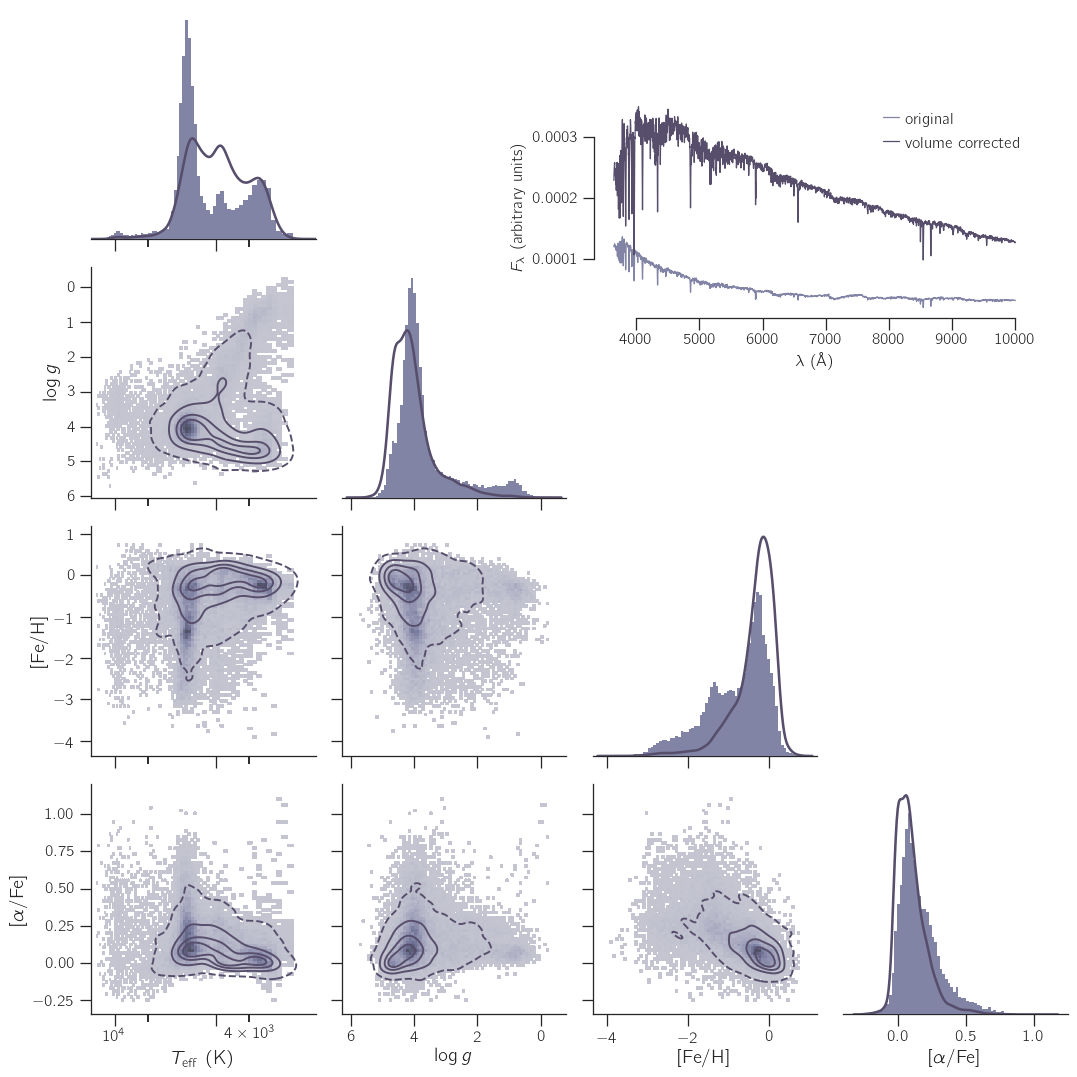Summary
In this site you will find the MaNGA Stellar Library (MaStar, Yan et al., 2019) physical parameters computed using CoSHA, a Code for Stellar Heuristic Assigment of physical parameters: effective temperature (\(T_\mathrm{eff}\)), surface gravity (\(\log{g}\)), iron abundance (\([\mathrm{Fe}/\mathrm{H}]\)) and alpha to iron abundance (\([\alpha/\mathrm{Fe}]\)).
CoSHA implements a Gradient Tree Boosting (GTB) algorithm to train a model for each property. GTB is a type of ensemble algorithm that trains a predefined number of decision trees in a serial way, so that each decision tree improves its predecessor. We used the GTB implementation in scikit-learn. Since we took an heuristic approach we did not changed the hyperparameters default values. In order to test de realiability of CoSHA we compared our results using external data sets such as APOGEE and tried to reproduce the known spatial trends in well-studied planes such as \([\alpha/\mathrm{Fe}]\) versus \([\mathrm{Fe}/\mathrm{H}]\).
To train/test CoSHA we used the first data release of MaStar (Yan et al., 2019) and the Göttingen Spectral Library (GSL, Husser et al., 2013). Both data sets comprise ~30k stars allowing for a wide parameter space coverage:
| min | max | |
|---|---|---|
| \(T_\mathrm{eff}\) (K) | 2300 | 12000 |
| \(\log{g}\) | -0.025 | 6.000 |
| \([\mathrm{Fe}/\mathrm{H}]\) | -4.0 | 1.0 |
| \([\alpha/\mathrm{Fe}]\) | -0.2 | 1.2 |
There are some limitations to using such data set to train CoSHA, being the most important the \(T_\mathrm{eff}\) coverage. We expect to expand the parameter space coverage in future updates of the catalogue. See Mejía-Narváez et al., 2021 for a discussion on other potential limitations.
Despite the above-mentioned limitations in the parameter space coverage, CoSHA recovers with high confidence most important parameter space distribution features.

Data Format
The catalogue comprises the atmospheric properties of over 22k stars from MaStar, as well as other physical and observed properties in a FITS file binary table. Below we describe the file structure.
There are two HDUs, the PRIMARY which for the moment will be empty and a binary table which contains the actual CATALOGUE:
No. Name Ver Type Cards Dimensions Format
0 PRIMARY 1 PrimaryHDU 4 ()
1 CATALOGUE 1 BinTableHDU 67 22771R x 21C [22A, E, E, 12A, 13A, E, E, E, E, E, E, E, E, E, E, E, E, E, E, E, E]
The first three columns contain identification and exposure information:
name = 'ID'; format = '22A'
name = 'RECORD'; format = 'E'
name = 'NEXP'; format = 'E'
The following four columns contain the right ascention, the declination, the distance and
the \(B-V\) color excess:
name = 'RA'; format = '12A'; unit = 'HH:MM:SS.ss'
name = 'DEC'; format = '13A'; unit = 'DD:MM:SS.ss'
name = 'DIST'; format = 'E'; unit = 'kpc'
name = 'EBV'; format = 'E'; unit = 'mag'
The next three columns contain the volume correction factor, the signal-to-noise ratio
across the wavelength range and the flux normalization computed as the median flux within
the 5490 — 5510Å wavelength windows:
name = 'VCORR'; format = 'E'
name = 'SNR'; format = 'E'
name = 'FNORM'; format = 'E'; unit = 'erg/s/cm^2/AA'
The next five columns contain the photometric magnitude in the SDSS ugriz
passbands:
name = 'USDSS'; format = 'E'; unit = 'mag'
name = 'GSDSS'; format = 'E'; unit = 'mag'
name = 'RSDSS'; format = 'E'; unit = 'mag'
name = 'ISDSS'; format = 'E'; unit = 'mag'
name = 'ZSDSS'; format = 'E'; unit = 'mag'
The next two columns represent the radial velocity and its associated error as computed by
the MaStar collaboration:
name = 'RADVEL'; format = 'E'; unit = 'km/s'
name = 'RVERR'; format = 'E'; unit = 'km/s'
And the remaining columns represent the physical properties derived by CoSHA:
name = 'TEFF'; format = 'E'; unit = 'K'
name = 'LOGG'; format = 'E'; unit = 'log/cm/s^2'
name = 'MET'; format = 'E'; unit = '[Fe/H]'
name = 'ALPHAM'; format = 'E'; unit = '[alpha/M]'
We plan to include the uncertainties associated with these quantities in a future release of
this catalogue. In the mean time, if you use this catalogue, please cite
Mejía-Narváez et al., 2021. If you have some requests or complaints please
send me an e-mail.
Changelog
- v1.0.0: First version.